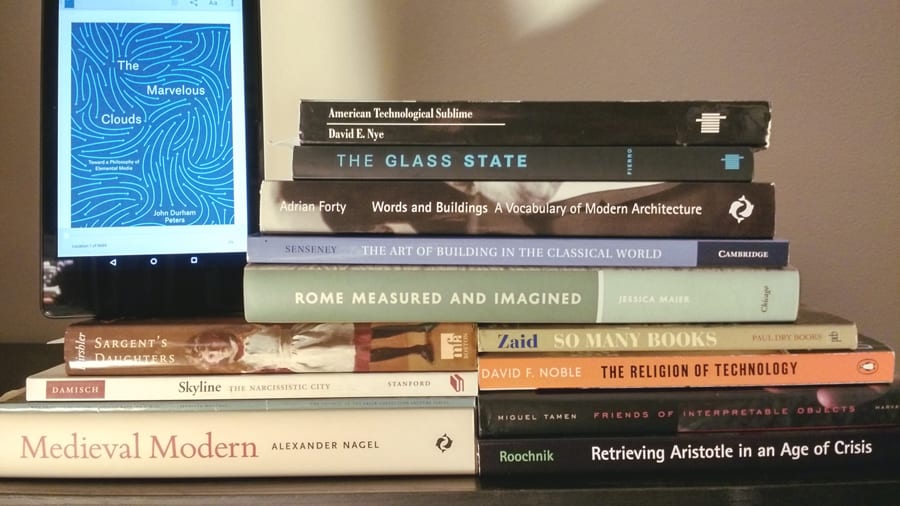There are two projects determining a large part of my current reading. The first is a book manuscript, in its early stages, on the relation of architecture and civic life in the US. The second is an exploration of architecture as “the technology of the public realm” in the nineteenth and twentieth centuries. Given the current fascination with the potential—and the pitfalls—of advancing digitalization, the time is ripe for an exploration of architecture’s contribution to this area of thought and experience. The literature that is potentially relevant to this research is vast; the books here are just a few that have made it to the top of my pile. Some of these books will end up being relevant to both writing projects, some of them to neither.
My reading has lately been divided between paper and digital, about 75% to 25%, respectively. This is a revolution in my reading habits, as I resisted digital reading until three or four years ago. I once thought it was good only for certain kinds of fiction and short nonfiction essays. But I’ve come to appreciate the particular sensuality of reading on a tablet: so different from paper and cloth, but alluring and beguiling in its own way. Still, digital books are not always good for many philosophical or theoretically challenging works, when the ability to quickly jump to endnotes, or to easily go back or forward to other sections, is critical to comprehension.
I am rarely satisfied by narrowly reading about one or two topics. There are books on this list outside of my current research interests. They provide intellectual sustenance that goes beyond any single area of study, no matter how rich and complex the literature in that one area may be. Plus, any bibliophile inevitably reads books about books. I just finished rereading Gabriel Zaid’s So Many Books (Philadelphia: Paul Dry Books, 2003), a short book filled with an abundance of acute and fascinating observations about bookishness, reading, and publishing. Zaid argues that the purpose of reading, and of collecting books we should admit we might never actually read, comes from how we feel, how we see, and what we do after reading them (or after planning the prospect of reading them). If culture, as he writes, “is a conversation without a center,” then “the universality accessible to us is the finite, limited, concrete universality of diverse and disparate conversations” 1. To be part of the conversation, through books, is the thing.
Hubert Damisch, Skyline: The Narcissistic City (Stanford: Stanford University Press, 2001)
Annette Fierro, The Glass State: The Technology of the Spectacle, Paris, 1981–1998 (Cambridge, MA: MIT Press, 2003)
Adrian Forty, Words and Buildings: A Vocabulary of Modern Architecture (New York: Thames and Hudson, 2000)
Erica E. Hirshler, Sargent’s Daughters: The Biography of a Painting (Boston: MFA Publications, 2009)
Jessica Maier, Rome Measured and Imagined: Early Modern Maps of the Eternal City (Chicago: University of Chicago Press, 2015)
Jennifer Montagu, Why Francois Du Quesnoy Should Have “Dy’d Mad”: A Reconsideration of Roman Baroque Sculptors’ Intentions. The Council of The Frick Lecture Series (New York: The Frick Collection, 2007)
Alexander Nagel, Medieval Modern: Art Out of Time (New York: Thames and Hudson, 2012)
David F. Noble, The Religion of Technology: The Divinity of Man and the Spirit of Invention (New York: Penguin, 1999)
David E. Nye, American Technological Sublime (Cambridge, MA: MIT Press, 1996)
John Durham Peters, The Marvelous Clouds: Toward a Philosophy of Elemental Media (Chicago: University of Chicago Press, 2015)
David Roochnik, Retrieving Aristotle in an Age of Crisis (Albany: State University of New York Press, 2013)
John R. Senseney, The Art of Building in the Classical World: Vision, Craftsmanship, and Linear Perspective in Greek and Roman Architecture (New York: Cambridge University Press, 2014)
Miguel Tamen, Friends of Interpretable Objects (Cambridge, MA: Harvard University Press, 2001)
Gabriel Zaid, So Many Books: Reading and Publishing in an Age of Abundance. Translated by Natasha Wimmer (Philadelphia: Paul Dry Books, 2003)
Paul A. Ranogajec is an independent art historian based in New York. He received his PhD from the City University of New York in 2014 and works at the Open Society Foundations. His research and writing covers the visual arts, design, and architecture from the Renaissance to the present, focusing on the nineteenth and early twentieth centuries.
- Gabriel Zaid, So Many Books: Reading and Publishing in an Age of Abundance. Translated by Natasha Wimmer (Philadelphia: Paul Dry Books, 2003), 33. ↩


